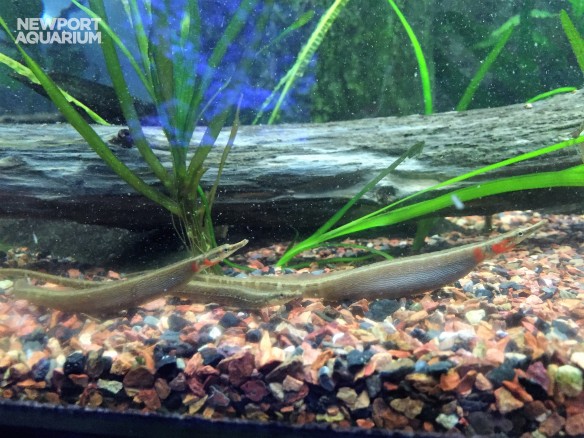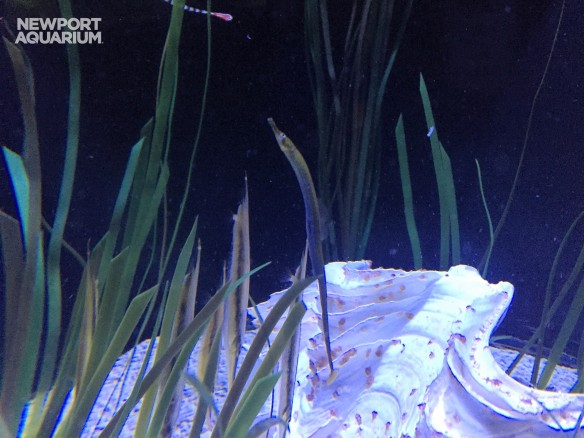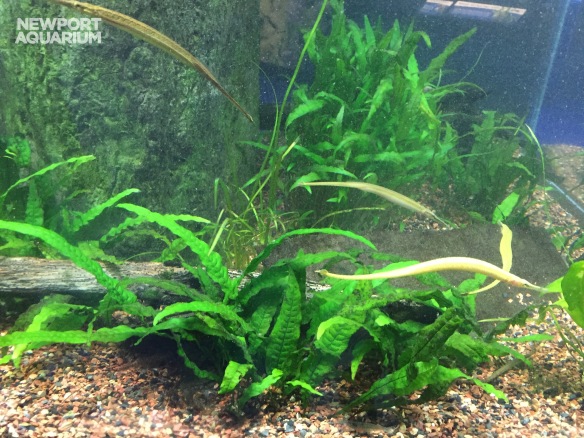Takeover Tuesday features a “day in the life” of biologists at Newport Aquarium. Be sure to follow us on Instagram, Twitter and Facebook.
Hi, I’m Sidney and I’m a Biologist at Newport Aquarium. One of my main focuses here is culturing live foods for animals like seahorse babies (called fry).

It’s important to culture live foods because they are generally much smaller in size than any of our frozen foods; so when we breed animals where their offspring are tiny, we ensure that we have food to feed them when they are born.
In the picture above, you can see me measuring the density of microalgae called Nannochloropsis. When it is dense enough, I can harvest it to feed to other microscopic live foods to make them more nutritious for the animals eating them.

African freshwater pipefish
These are African freshwater pipefish. They are in the same exhibit as the opossum pipefish. Look closely for these, though. They are normally hiding under rocks or deep in the plants! The males have pouches just like male seahorses do to hold eggs. Sometimes, these pouches swell and turn a pretty blueish color.
Out of all the animals under my care, my personal favorite is the dwarf gulf pipefish I have lovingly named Hank.

Hank, featured in the center of this photo, is a dwarf gulf pipefish.
I found Hank in a live food delivery as bycatch when he was barely an inch long and cared for him until he was big enough to go on exhibit. Hank can be found in the dwarf seahorse exhibit, usually blending in with the tall grass around the shell.

It’s breakfast time for the dwarf seahorses! What’s on the menu? Mysis!
Right now I am feeding the dwarf seahorse exhibit. This is mysis shrimp in my container, a small shrimp that comes frozen. We thaw it out and then feed it to our exhibits with measuring spoons so that we give the animals the perfect amount of food each time.
Every month or so, I dive into the freshwater pipefish exhibit to scrub algae. This exhibit has live plants in it, so after I scrub, I prune everything and divide a few of the java ferns and sword plants to transplant to different parts of the tank.
Because of the columns in the center of this exhibit, diving to scrub can be challenging. I often end up in acrobatic positions just to reach some of the corners!

Male pipefish, just like all male seahorses, carry the eggs. Thanks, dad!
These yellow pipefish are called opossum pipefish. They are one of two pipefish species in this exhibit and tend to stay in the middle of the water column. They eat mysis and brine shrimp and sometimes you can see some of the males carrying eggs on their undersides.
Once a week I dive in the paddlefish tank to give it a good scrubbing. It is pretty big – 6,500 gallons – so it usually takes me at least an hour.

Getting ready to go into the paddlefish tank.
There are roughly 50 paddlefish in the tank with me but they tend to stay out of my way while I work. I appear blue in this photo due to the lighting over the tank. This color light is just for exhibit aesthetics and doesn’t serve a purpose for the paddlefish.
Thank you for joining me for today’s Takeover Tuesday!


Pingback: Takeover Tuesday: Tide Pool Edition | Aquarium Works